Multicoder User Manual
Introduction
The aim of this document is to guide the user through the functionalities of the Multicoder application, which is the software running on the following Barix Products:
Barix Flexa enabled devices are:
PN | Description |
2023_9434P | Multicoder M400 EU package |
2023_9435P | Multicoder M400 US package |
2023_9436P | Multicoder M400 UK package |
2023_9437P | Multicoder M400 NoPSU package |
The Multicoder Application is running on the top of the “Flexa” firmware. This applications can only run on top of these “Flexa” devices, it is not possible to install the “Flexa” firmware on any other device and it is not possible to convert any other device into a “Flexa” one.
This manual is written based on the latest Flexa firmware image v2.2.8 released and the first Multicoder application v1.1.0.
What is Multicoder ?
The Multicoder is an audio encoder for low latency applications. It supports up to 4 internal encoding engines, each can send maximal 10 streams (depending on used codec). As audio codecs are available OPUS, AAC+, MP3, PCM and G.711. For the streaming are the RTP protocol and the Barix invented BRTP protocol available. Up to 40 streams can be send at the same time to different targets, depending from the used audio codec (with G.711 and PCM 8 kHz only, other codecs allow a lower number of possible streams).
General Features
4 internal encoders
max 10 streams per encoder
Line-in mono/stereo (configurable)
generic USB audio driver for support of USB audio sources (e.g. USB Microphone or USB Mixer)
supported audio codecs: OPUS, AAC+, MP3, PCM, G.711
Protocols: RTP, BRTP
Streaming modes: Send Always, Send on Level
Audio inputs: mono left, mono right, stereo, stereo downmix
configurable SSRC
HTTP/HTTPS websetup
embedded SDP file creator
About this manual
This manual is intended for distributors, installers and end users of the Multicoder solution. It will cover first configuration steps plus details on how to use the applications after installation.
This manual describes the functionality of the latest Flexa firmware version and latest overlaying Multicoder application.
Barix always recommends to run the latest software available on the device and provides a dedicated download area for registered users on https://help.barix.com.
Multicoder application is available from the Barix Cloud Portal only (only downloadable from the device after registration).
Additional documents and support
The following additional documents are available for the IP Audio Client application:
Quick Install Guide - Multicoder
Multicoder - Knowledge Base articles
Product sheets: These documents are available for download on the Barix website for all users in the download area www.barix.com/downloads
Beside checking regularly the Barix website and the Barix help, the user has access to support in several ways:
Check with your local distributor for the technical support they offer. A list of distributors is also available on the Barix website at this link
Email directly a Barix support technicians at support@barix.com
Quick Start
The Multicoder devices offer the possibility to connect to the wired IP networks (10/100Mbps).
The device has to be powered with the supplied external 5VDC power supply.
The Multicoder, by default, is configured to be a DHCP client, it acquires an IP address from a DHCP server reachable in the network.
The first configuration of the device involves the following steps:
1 | Make all the necessary connections: audio, network and then power up the unit |
2 | During boot the device will announce its IP Address (Sonic IP function), make sure to hear the audio on the headphone output and note the IP address on paper. The Multicoder device takes between 40sec to 50sec to finish the boot process. Alternatively use the Barix Discovery tool to find out the IP address of the device. |
3 | Use your Web browser to connect to the IP Address of the device by typing in the URL the IP address just heard or have found in the discovery tool. |
4 | When the device is asking for login then enter username and password (username: admin - password: printed on the backside of the device) - After login, we recommend to change the default password. Please change the default password immediately under Security Settings in the Settings Page and make sure to store it in a safe place!  Change password function in Security settings When you change the password, then you have to enter in the first field the current password, and in the next fields the new password (one time for confirmation). Thereafter click on “Submit” to save the settings. |
5 | Now set the settings for the audio encoding. When you are on the Settings tab, after 1 or 2 seconds a “Multicoder Settings” button will appear on the top of the list. Click on it to change the encoder settings. 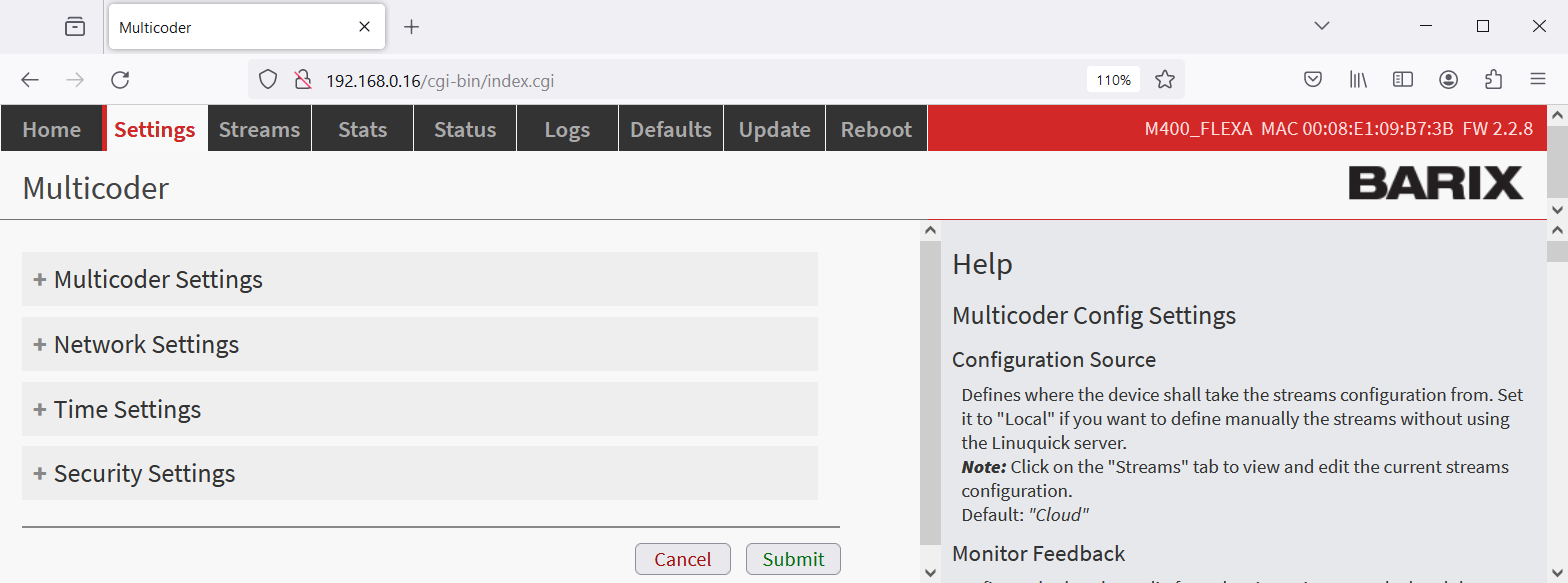 Settings overview 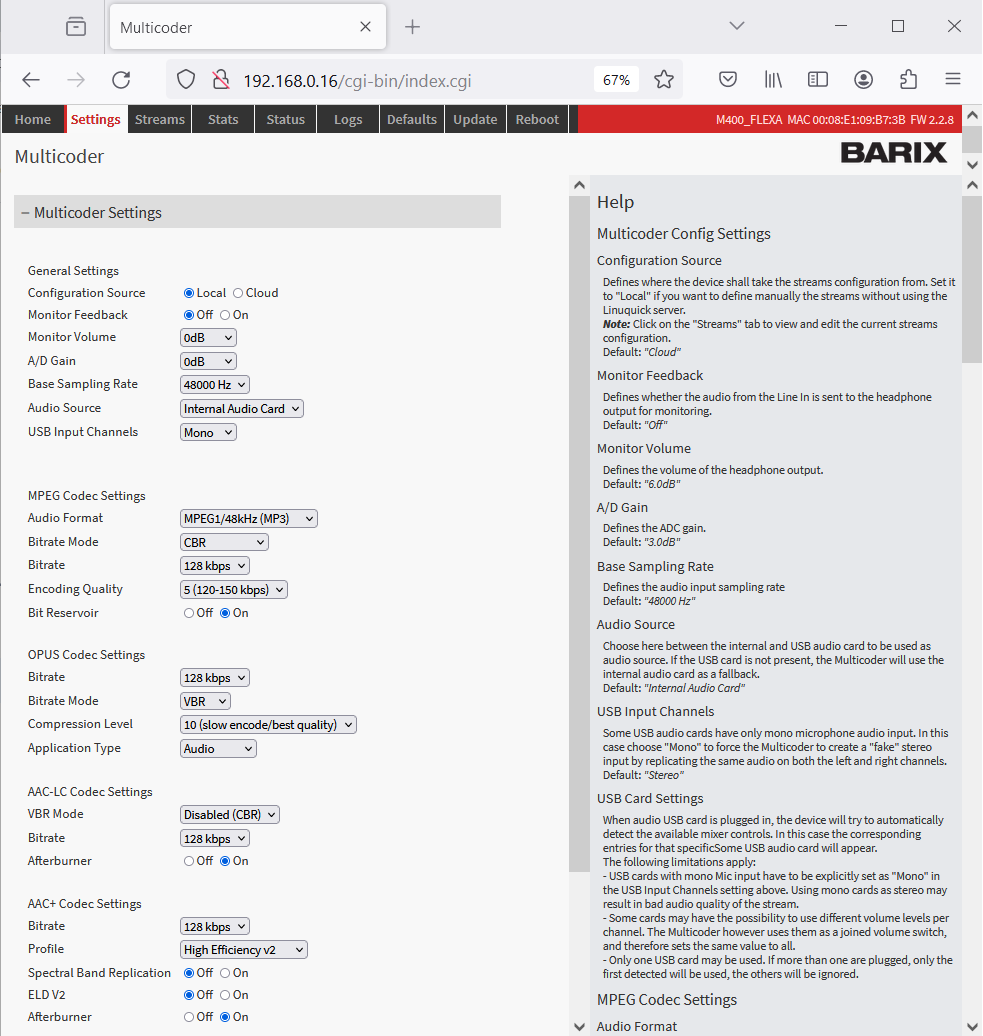 Multicoder Settings Here make your preferred setup, thereafter scroll down and click “Submit” to save and use the settings. |
6 | As last step click “Streams” in the top menu to configure your streaming targets. |
This was a Quick Start chapter to get the device up and streaming in 5 minutes. The rest of the manual details every function available within the application.
Getting IP address from the device
In this chapter are detailed all the methods that can be used to retrieve IP Address of the Multicoder.
Retrieve the IP address using the Sonic IP® function
All Barix audio devices are equipped with a function called “Sonic IP®”, meaning that when you boot the device and this is connected to a network where a DHCP server is present, the device will acquire an IP address and announce it over its audio output. This function is useful when you connect to the device for the first time and need to access its web interface for performing the first configuration. The Multicoder is playing out the IP address directly after reboot on the headphone output on the front of the device.
IMPORTANT: Attention, because the audio level could be on some headphones too high or too low, depending on the impedance of the connected equipment and the used volume settings in the Multicoder.
Follow the below steps to take advantage of the SonicIP function:
Connect the audio output to the receiving system, this varies depending on the Barix Multicoder being used
Make sure the receiving system works fine so that when the Barix device boots you are able to hear the IP Address
Power up the device.
After 20s listen to the Sonic IP® announced and note it somewhere
After 35s the device is ready
Retrieve the IP address using the Discovery Tool
Other than the Sonic IP® function, there are other ways to find out a Barix device’s IP address. One is by using the Discovery Tool from Barix.
The Discovery Tool is freely available for download from https://help.barix.com/tools/discovery-tool.
The Discovery Tool is written in the Java programming language, so it requires a Java Runtime Environment (JRE) installed on your computer. If you do not have a JRE installed, you can download and install it from: https://www.java.com/en/download/
Java run time environments are available for many major operating systems. If you are running the Discovery Tool on a Linux or UNIX platform, the Discovery Tool also requires the X-window graphical user interface.
The Discovery Tool is distributed in a Java Archive (.jar) file. On most operating systems you can run the Discovery Tool by simply double-clicking on the discover.jar file.
Click the "Get" button to initiate a search. The program will scan the local network and list all the Barix devices found with its current IP address, MAC address (labeled "Ethernet Address" in the Discovery Tool), firmware version, and other information. On the picture below you can see how it looks when a Multicoder is found:
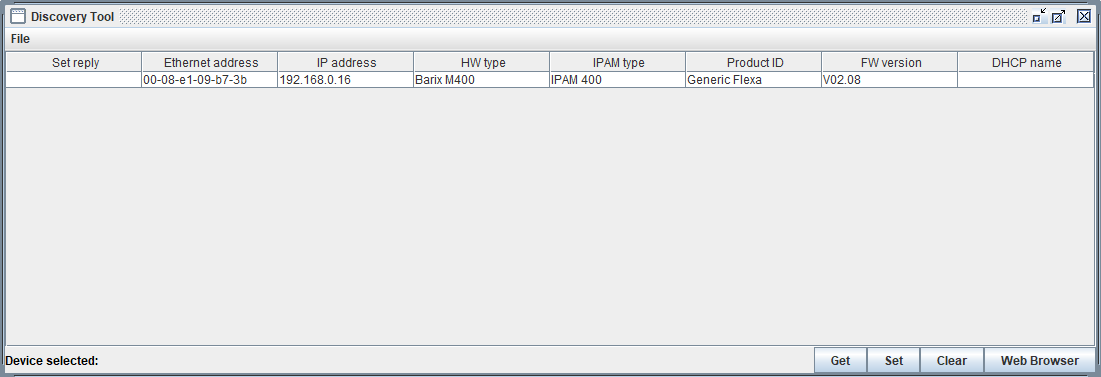
Barix Discovery Tool with discovered Multicoder
The Discovery Tool will find all Barix devices that are on the same network as the computer running the tool, regardless of their current IP address setting. The tool will not search through a router to another subnet. Use the address that appears in the Discovery Tool to access the Barix device via a web browser.
Setting a static IP Address using the Discovery Tool
In the discovery tool window Double click the IP Address field of the device which you want to change set the Static IP Address
Enter the IP address you want to assign.
Click SET in the lower right corner - the tool will reply with a “No error” in the “Set reply” column.
Reboot your device and access the web interface through the newly assigned IP Address. Make sure to finalize the network settings configuration (Subnet, Gateway, DNS), otherwise the device might not work correctly.
If the Barix discovery tool is not discovering Barix devices in the local network, then make sure you have not opened the Discovery tool twice on the same PC or any PC firewall is blocking the traffic.
Homepage
When you browse the IP address of the Multicoder and you have logged then you will see the homepage on your browser. On the homepage of the Multicoder is the VU meter and device information available.
The window is organized in:
The top navigation bar. In addition on the top right corner there are the MAC address and current firmware installed on the device
The information area. Where the user can see the audio input status and the application status.
The help section on the right side of the window/page.
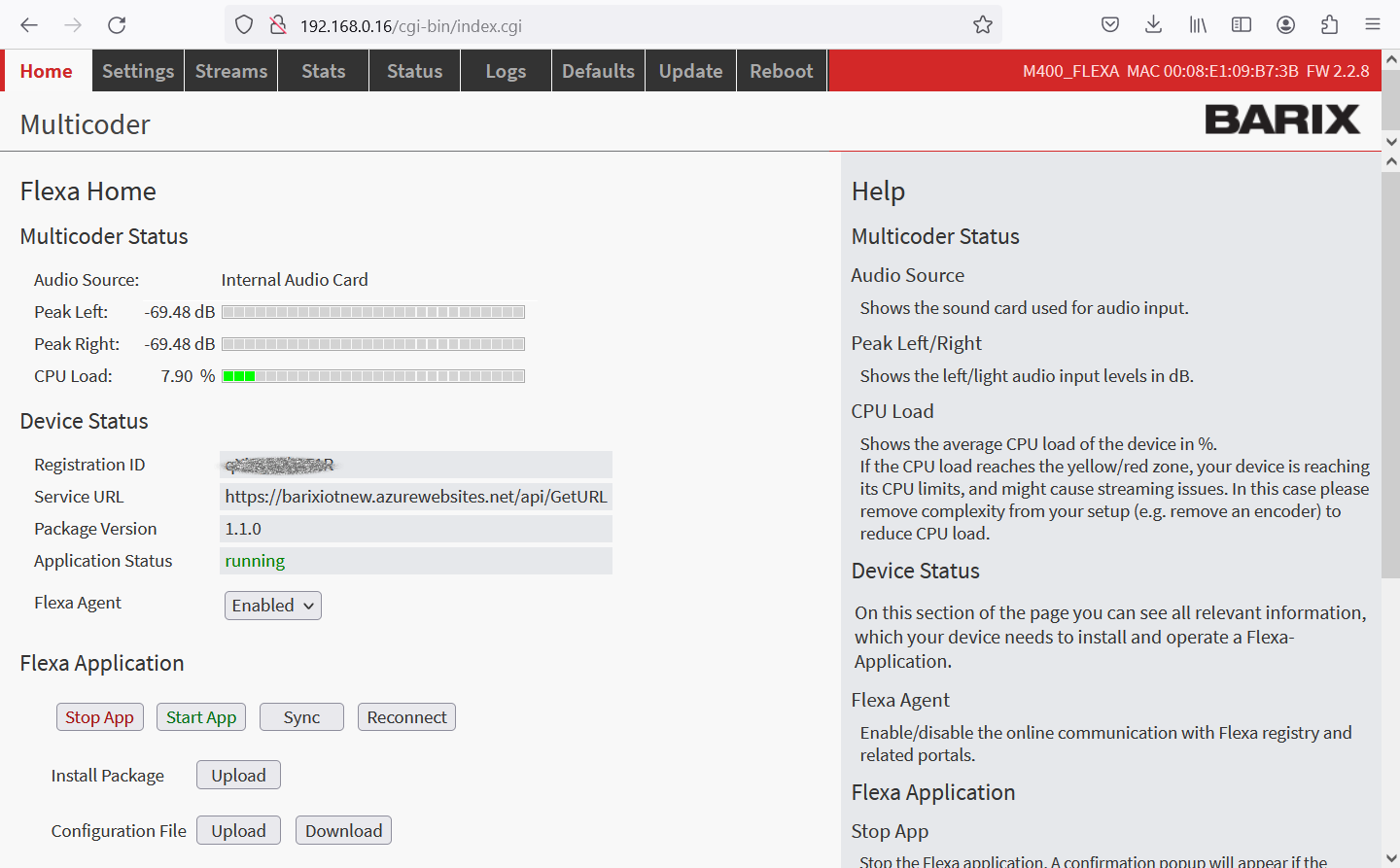
Multicoder Home page
On the right side of the page you find an online help, the left side of the page gives you information about the application and the device-/audio status.
Multicoder Status
Shows you the currently use audio input, it can be the “Internal Audio Card” of the Multicoder or it can be an optional “External USB Audio Card” which can be connected to the Multicoder’s “ext.” port on the front of the device.
Peak Left/Right shows the current audio input level. Green (up to -12 db) and Yellow (from -12dB to -3dB) state are good audio levels.
Red color is already a warning level and when you reach 0 dB then you should reduce the volume level at your audio source, otherwise you will experience audio clipping.
CPU Load shows the CPU utilization of the device. After you have configured the Audio & Streams settings monitor the CPU meter for 30 seconds for the maximum CPU load. When the load is sometimes more than 36% then the number of streams or the bandwidth should be reduced otherwise it could have effects on the audio quality.
Device Status
The Registration ID and Service URL are information the device needs to contact to the Barix Cloud portal.
In the future you will be able to manage your Multicoder devices on the Barix cloud portal.
Package Version is the current Multicoder application version and the Application Status shows you the application currently running or stopped. If stopped then the device will not stream and the other settings are probably not available.
Flexa Agent is the Barix cloud portal, per default the setting is enabled.
Flexa Application
Usually all these buttons are not needed under normal circumstances.
The buttons Start App/Stop App allow to start/stop the Multicoder application manually.
The Sync button and the Reconnect button forces the device to connect to the Barix Cloud portal, but for that the device must be registered on the Barix Cloud portal.
Install Package and Configuration File are currently not supported functions on the Multicoder
Settings
Under Settings you can configure device specific settings.

Settings overview
Here you can find the sub menus for Multicoder Settings, the Network Settings, the Time Settings and the Security Settings. Note, the Multicoder Settings button needs 1-2 seconds until it is displayed.
Also here you can find an online help on the right side of the page.
Click on the desired button to open the according menu.make you changes and finally scroll down and click “Submit” to save the changes and make the changes active.
Multicoder Settings
Here you can set the audio and codec options.
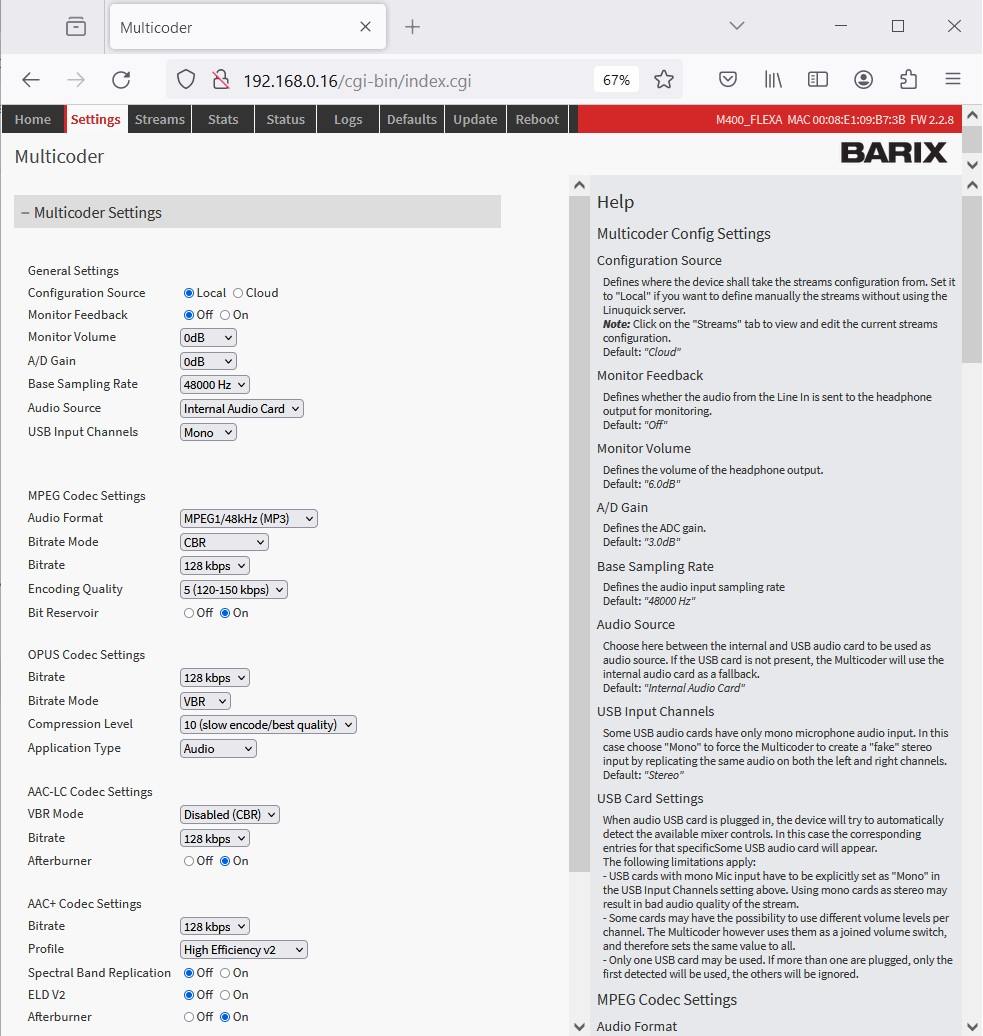
Multicoder Settings
Item | Available value | Description |
|---|---|---|
Configuration Source | Local, Cloud | Currently you can only use “Local”, the “Cloud” option does currently not work but will come in the future. Default is “Local” |
Monitor Feedback | Off, On | Enable this function when you have the audio from the line-in interface also on the headphone interface for monitoring. Default value is: "Off " |
Monitor Volume | -4.5dB, -3dB, -1.5dB, 0dB, 1.5dB, 3dB, 4.5dB, 6dB | Defines the volume of the headphone output. |
A/D Gain | -4.5dB, -3dB, -1.5dB, 0dB, 1.5dB, 3dB, 4.5dB, 6dB | Defines the ADC gain, the amplification of the audio input. |
Base Sampling Rate | 44100 Hz , 48000 Hz | Defines the audio input sampling rate for AAC+ and OPUS. |
Audio Source | Internal Audio Card, | Choose here between the internal audio card or USB audio card to be used as audio source. The USB audio card should be only selected when a USB audio device is connected to the Multicoder. If the USB card is not present, the Multicoder will use the internal audio card as a fallback. When audio USB card is plugged in, the device will try to automatically detect the available mixer controls. In this case the corresponding entries for that specific USB audio card will appear.
Note, each USB card has its own parameters, like Gain, Volume or others. For that reason the Setup for the USB could look different with different USB audio devices. |
USB Input Channels | Mono, Stereo | Some USB audio cards have only mono microphone audio input. In this case choose "Mono" to force the Multicoder to create a "fake" stereo input by replicating the same audio on both the left and right channels. |
MPEG Codec Settings | ||
Audio Format | MPEG1/48kHz (MP3) | Defines the MPEG format used for encoding the stream |
Bitrate Mode | CBR, VBR - quality | Defines the bitrate mode used to encode the MP3/MP2 stream |
Bitrate | 32kbps - 320 kbps | Configure constant bitrate between 32 kbps and 320 kbps |
Encoding Quality | 0 - 9 | Defines the MPEG stream quality in VBR mode |
Bit Reservoir | Off , On | Enables or disables the use of MPEG bit reservoir. For CBR mode the Bit Reservoir should be “On” for VBR the Bit Reservoir should be “Off”. |
OPUS Codec Settings | ||
Bitrate | 32 kbps - 320 kbps | Configure constant bitrate between 32 kbps and 320 kbps |
Bitrate Mode | VBR, CBR, CBVR | Defines the bitrate mode used to encode the OPUS stream
Default: "VBR" |
Compression | 1 - 10 | Defines the compression level used to encode the OPUS stream |
Application Type | Audio (for music), VOIP (for voice), Low Delay | Defines the low bitrate tuning algorithm used to encode the OPUS stream |
AAC-LC Codec Settings | ||
VBR Mode | Disabled (CBR), 32kbps, 40kbps, 48 - 56kbps, 64kbps, | Defines the bitrate mode used to encode the AAC-LC stream |
Bitrate | 32 - 320 kbps | Configure constant bitrate between 32 kbps and 320 kbps |
Afterburner | Off, On | Enables a special analysis by synthesis algorithm that increases the audio quality |
AAC+ Codec Settings | ||
Bitrate | 32 - 320 kbps | Configure constant bitrate between 32 kbps and 320 kbps |
Profile | High Efficiency | Defines the AAC profile used to encode the AAC-LC stream. Default: "High Efficiency V2" |
Spectral Band Replication | Off, On | Enables the SBR if ELD AAC profile is selected |
ELD V2 | Off, On | Enables the LD-MPS extension for ELD stereo signals when AAC ELD profile is selected |
Afterburner | Off, On | Enables a special analysis by synthesis algorithm that increases the audio quality |
Network Settings
In this area, it is possible to configure the device’s network interface and few other functions.
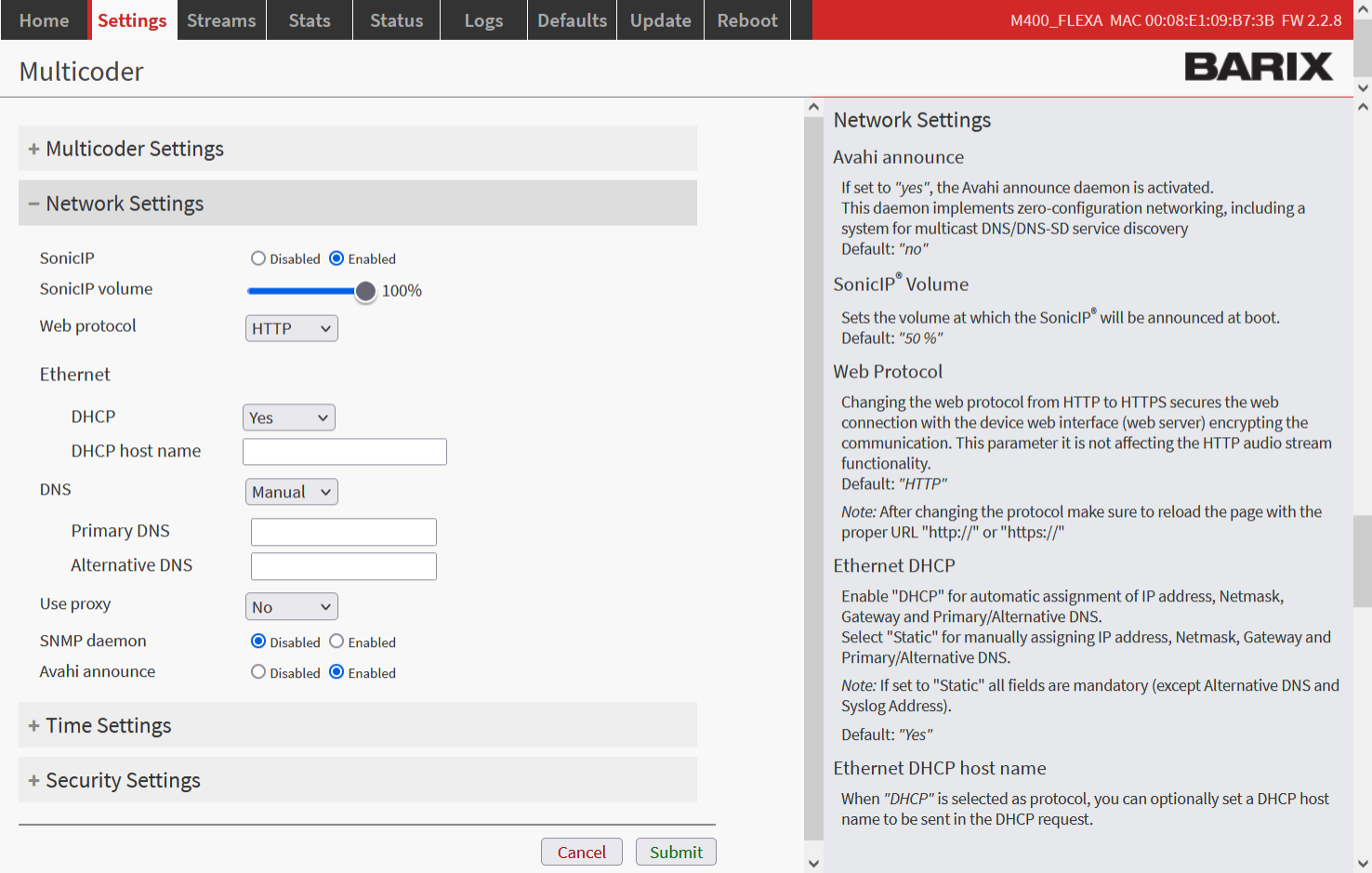
Network Settings
Per default setting the Multicoder supports the Dynamic Host Configuration Protocol (DHCP), which allows the device to acquire an IP address available from a pool of addresses hosted by a DHCP server. It is the server that offers an IP address to the device when discovered on the network. The IP address offered by a DHCP server comes with a lease time, meaning that when the leased time is over the DHCP server re-issues the IP addresses to the devices on the network, with the possibility that it might assign a different address than the one assigned previously. In addition, the DHCP server provides all associated information to the requesting device, such as subnet, gateway, and DNS addresses.
Item | Available values | Description |
|---|---|---|
Sonic IP / Sonic IP Volume | Enable , Disable | Enable / Disable the Sonic IP function so the device announces its IP Address directly after the boot process. Default: Enable Set the volume of the SonicIP with the corresponding slide. Default: 50% |
Web Protocol | HTTP, HTTPS | Configure the protocol used to access the web interface of Multicoder. It can be HTTP or HTTPS. When set in HTTPS the communication between the browser and the device is encrypted. The application uses a self-signed certificate for the SSL/TLS authentication, not one from a CA (Certificate Authority) considered safe from web browsers. For this reason when using HTTPS the browser will warn that the certificate used is not a trusted one (NET::ERR_CERT_AUTHORITY_INVALID). To continue and open the web interface it is necessary to advance manually, “forcing” the browser to trust the self signed certificate. The connection and data communication will be fully encrypted. Default: HTTP |
DHCP | Yes, No | Set the DHCP (Yes) or Static IP addressing mode (No). Default: DHCP |
DHCP host name Only available when DHCP =Yes | Provides the DHCP with an host name to easily identify the device in the DHCP list of leased IP addresses. Default: " " | |
IP Address Only available when DHCP=No Netmask Gateway IP Address | Configure here the fix IP address for the Multicoder when DHCP is disabled. The IP address is the unique identifier of a device on a network, in case of static assignment make sure that no other device on the same network has the same IP address assigned to the Multicoder | |
In addition to the IP address, it is mandatory to provide information about the subnet mask. The subnet mask indicates which bits in the IP address are used for the network portion and which bits for the host portion. It is common in Class C LAN to see 255.255.255.0, this configuration indicates that the first 3 octets of the IP address (e.g. 192.168.0.100) are dedicated to the network identification, while the last octet (e.g. 192.168.0.100) is dedicated to the host identification on the network. | ||
The Gateway IP is the address of the device that bridges your Local Area Network with other networks or the Internet. Typically is a router where devices on a LAN are connected. For using the Multicoder in all its cloud-based features, but also to receive a stream from an internet radio in stand-alone mode, for example, it is essential to provide this address. If you are not sure about the Gateway address in your network contact your network administrator. | ||
DNS | Auto , Manual | Set here whether you will use the DNS settings from the DHCP server (Auto) or you will use set your own DNS settings (Manual). Default: Manual |
Use Proxy Only available when Proxy enabled Host Port User Name User Password Exceptions | Yes, No | Enable/disable proxy settings. If your network uses a proxy server then you have to enable this function. Default: No If set to “Yes” you can configure the following settings: Set here the proxy server hostname/IP address. Define here the proxy server port. Configure the proxy user name. Configure the proxy user password. List here the Proxy exception as a list of comma separated entries. If empty, mean no exceptions. Allowed format for entries
|
SNMP daemon | Disable, Enable | Enables/disables SNMP protocol Default: Disable |
Avahi Announce | Disable, Enable | Enable/disable Avahi Announcement Default: Enable |
Time Settings
The Multicoder currently has no scheduling function, nevertheless supports the operating system the NTP protocol and in the setup you can configure the time servers. The Multicoder uses an NTP daemon to set its system time, this time e.g. used in the internal LOG files. The NTP protocol is used on the standard port 123.

Time Settings
Here you can configure the IP address or DNS address of the NTP servers.
Default: “1.barix.pool.ntp.org”
“2.barix.pool.ntp.org”
“3.barix.pool.ntp.org”
By leaving the configuration fields empty it is possible to disable the NTP function.
Security Settings
This area is dedicated to secure the login to the device web interface device and to enable or disable the possibility to run critical operations: reboot, reset to factory defaults and update
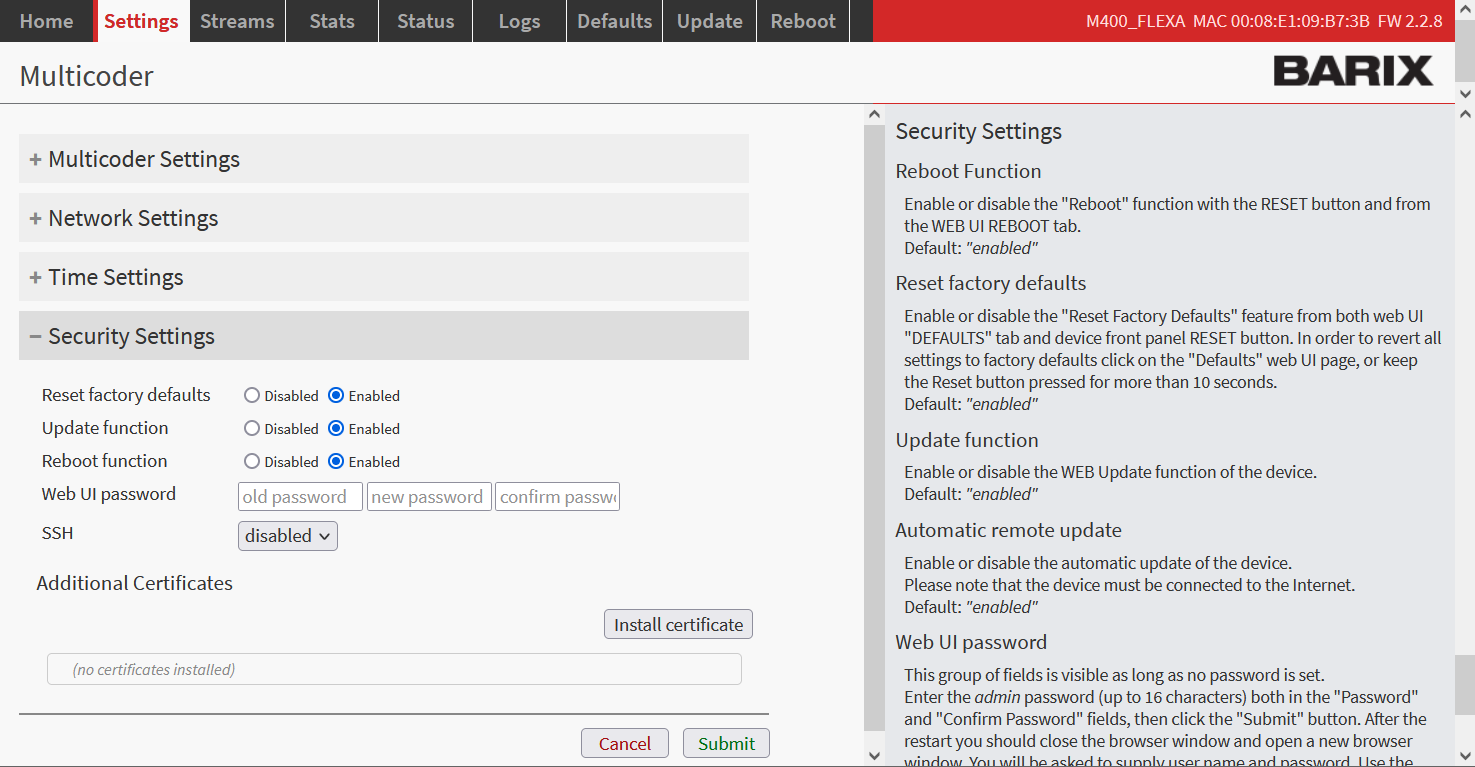
Security Settings
Item | Available values | Description |
|---|---|---|
Reset Factory Defaults | Disable, Enable | Enable or disable the possibility to reset the device to factory default from the web UI. Default: Enabled |
Update Function | Disable, Enable | Enable or disable the possibility to update the device from the web UI Default: Enabled |
Reboot Function | Disable, Enable | Enable or disable the reboot function of the device from the web UI Default: Enabled |
Web UI Password | Set the password to access the web interface of the device. If a password is already set another field is displayed: OLD PASSWORD, which is required to modify the current password. When you set a new password then you have to ente it twice for confirmation. default password: printed on the backside of the device The default user name is “admin” and cannot be changed. | |
SSH Access | Disable, Enable | Enable or disable SSH service. Only enable SSH Access upon request of Barix support, otherwise leave the option disabled. Default: Disabled |
Additional Certificates | Allows the possibility to upload custom .crt certificates to the device. Useful when the device is used in private enterprise networks where a private CA is in place to validate secure connections. Default: None |
Note, it is recommended to change the password when you connect the first time to the device.
Stream Settings
The Stream settings will exist in the menu only when the Multicoder application is loaded and running. If you don´t see the “Streams” button in the top menu, then please check the application status on the “Home” page.
On the “Streams” page you can configure the streaming destination and the way how to stream.
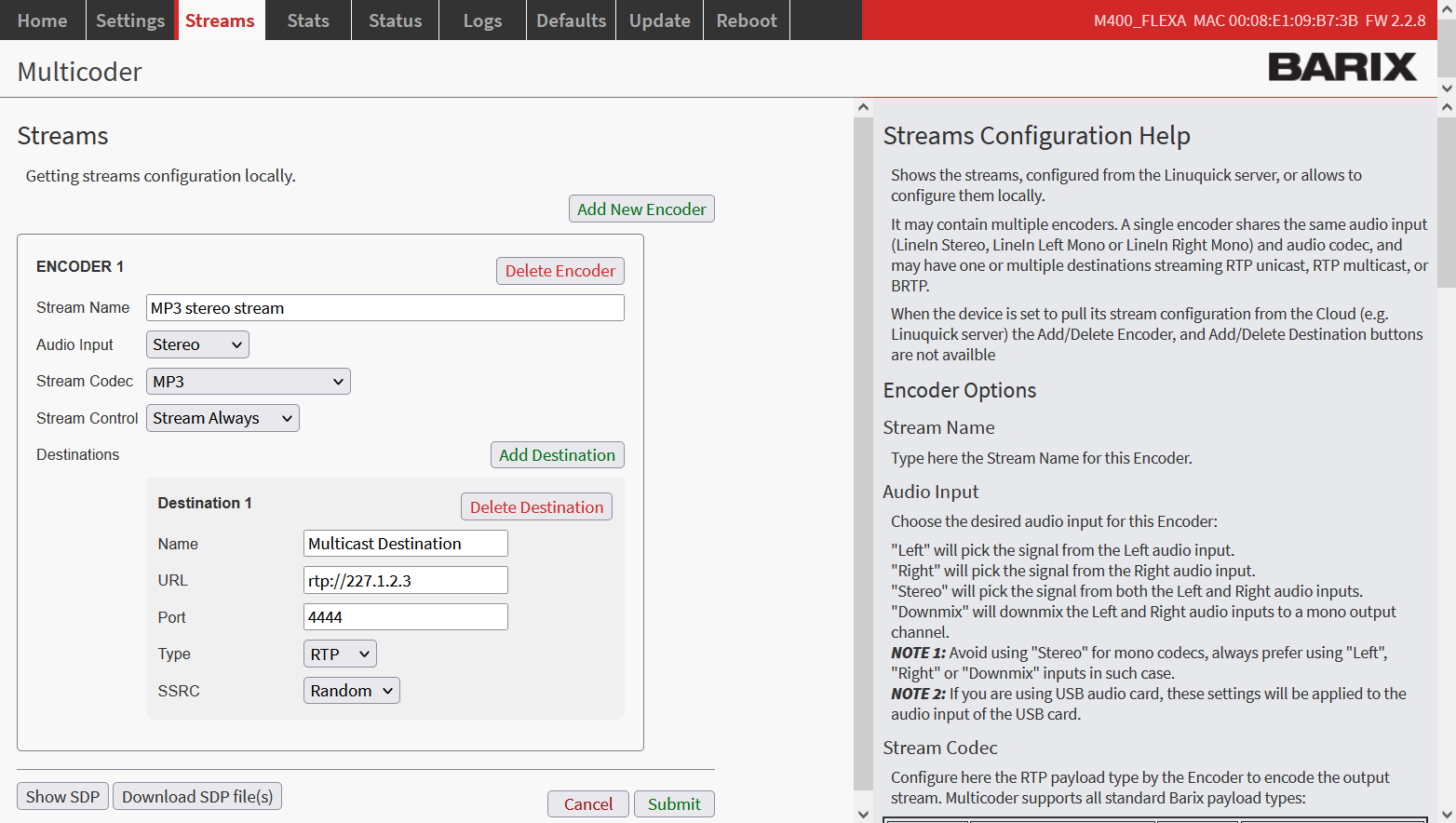
Streams settings
To add more encoder instances click “Add New Encoder”, If you will delete an existing encoder then click “Delete Encoder” within the according encoder box.
4 internal encoding engines are available, for each you can configure up to 10 streaming destinations. When using multiple encoding engines, then they can use the same or even a different stream codec for each engine.
To add a new streaming destination click “Add Destination” in the according encoder box.
To delete an existing destination click “Delete Destination” on the according destination.
After any changes don´t forget to click “Submit” to save and apply the settings.
The changes will get active directly after clicking “Submit”.
By clicking on CANCEL all the changes are not applied and the fields return to their previous inserted value.
The “Show SDP” and “Download SDP” buttons allow get the streaming parameters in SDP file format, that could be helpful to import the format on the receivers/players (e.g. Exstreamer M400 or Annuncicom MPI400).
Item | Available values | Description |
|---|---|---|
Stream Name | Type here the Stream Name for this Encoder or leave it empty. Default: “MP3 stereo stream” | |
Audio Input | Left, Right, Stereo, | Choose the desired audio input for this Encoder: "Left" will pick the signal from the Left audio input. NOTE 1: Avoid using "Stereo" for mono codecs, always prefer using "Left", "Right" or "Downmix" inputs in such case. |
Stream Codec | Configure here the RTP payload type by the Encoder to encode the output stream. NOTE: The encoding options for MP3, AAC, AAC+ and OPUS codecs can be configured from | |
Stream Control only visible with “Send on Level” Trigger Level Post Trigger Pre Trigger | Send on Level, | Define here how the stream is started. Configure here the input audio level (in dB) above which the device will start sending a stream. Post Trigger value can be adjusted to prevent cut offs when audio should be sent longer than detected. It defines the amount of time that the device will continue streaming after the actual trigger has been cleared. Pre Trigger value can be adjusted to prevent cut offs when audio should be sent earlier than detected. It defines the amount of time that will be buffered and streamed before the actual trigger occurred to avoid loss of audio when the stream starts. |
Destinations | ||
Name | Set here a meaningful name for this destination. | |
URL | The multicast/unicast address where the stream should be sent to. | |
Port | The destination port where the stream should be sent to. | |
Type | RTP , BRTP | Here select the streaming protocol. With BRTP the Multicoder device acts as a BRTP server, and can provide RTP unicast streams to requesting listeners. For that you need a client/listener which also supports BRTP (e.g. Exstreamer Streaming Client) |
SSRC | Use MAC Random Custom | Configure here the SSRC of the RTP stream. The SSRC is the stream identifier in the stream header. "Use MAC" will generate SSRC from the first 31 bits of the device MAC address. "Random" will set randomly generated SSRC for this stream, for the most customers the best option. "Custom" will allow you to set your own SSRC. Default: "Random" |
NOTE: The encoding options for MP3, AAC, AAC+ and OPUS codecs can be configured from the Settings -> Multicoder Settings page. This means that you cannot have Encoders with different settings for the same codec, e.g. it is not possible to have one MP3 stream with 128 kbps and another with 320 kbps on the same device.
Supported RTP Payload Types
Here is the list of used RTP Payload types. Some of these are standardized some other are Barix specific.
Payload | Description | Payload | Description |
0 | G.711 8kHz uLaw mono | 104 | 8kHz PCM LE, mono |
8 | G.711 8kHz aLaw mono | 105 | 24kHz PCM LE, mono |
10 | 44.1kHz PCM BE, stereo | 106 | 32kHz PCM LE, mono |
11 | 44.1kHz PCM BE, mono | 107 | 44.1kHz PCM LE, stereo |
14 | MP3 | 108 | 48kHz PCM LE, stereo |
96 | 8kHz PCM BE, mono | 109 | G.711 12kHz uLaw, mono |
97 | G.711 24kHz uLaw, mono | 110 | G.711 12kHz aLaw, mono |
98 | G.711 24kHz aLaw, mono | 111 | 12kHz PCM BE, mono |
99 | 24kHz PCM BE, mono | 112 | 12kHz PCM LE, mono |
100 | G.711 32kHz uLaw, mono | 124 | AAC-LC. stereo |
101 | G.711 32kHz aLaw, mono | 125 | OPUS, stereo |
102 | 32kHz PCM BE, mono | 126 | AAC-HE/HEV2 stereo |
103 | 48kHz PCM BE, stereo |
|
|
Over the “Show SDP” function you get the SDP script which you can use to configure the stream receiver for the according incoming stream. The bold marked formats are standardized formats. These formats should be supported from all RTP players without additional SDP file, but even there SDP description could be helpful to simply the setup.
Stream Limitations
The Multicoder supports upto outgoing 40 streams. But this 40 outgoing streams can reached in good quality only with G.711 8-24 kHz mono or with PCM 8 - 24 kHz mono. With higher stream quality bandwidth you should reduce the number of streams/encoders. With high quality stereo streams in MP3, AAC+ and PCM, you should not use more than 12 streams, otherwise you could overload the Multicoder device and that will result in bad audio quality (mainly in wrong frame timing).
A very good indicator is here the CPU meter on the Home page, monitor that for approx. 30 seconds, when it stays always below 36% then the Multicoder has enough resources for all the configured streams.
When the CPU utilization is higher than 36.0% then there is a chance for more or less streaming errors.
Note, the VU meter and CPU meter also takes resources, for that reason you should close that page if not needed.
With BRTP stream only 1 BRTP instance should be used per internal encoder for low quality codecs (G.711 8-24 kHz and PCM 8-24 kHz). For high quality codecs only one BRTP instance per Multicoder should be used.
In such case even additional RTP streams can be used, but check CPU limit (approx 36%) on the Home page.
One BRTP instance can be used from multiple clients/listeners.
Note, the SDP file does not know the parameters for PCM Little Endian (LE) for that reason the PCM little endian streams are not compatible with the Exstreamer M400. When you will stream to Exstreamer M400, then please use PCM Big Endian (BE). For Exstreamer Streaming destinations all PCM formats can be used.
Getting Started
The Multicoder is based on the Flexa firmware. Flexa is dynamic platform which allows to run various applications. But for now the device is only licensed to the Multicoder application.
So the software for the Multicoder consists of two parts, the Flexa firmware and the Multicoder application.
The firmware can be loaded over our central software server or from help.barix com. The Multicoder application is only available over our Cloud software distribution server. Only the device directly can download it, for that it needs internet access !
It is even planed to integrate the Multicoder on our central management platform, but currently that function is not supported, even you will find it in the setup.
Device Setup
Prepare the device to receive the Flexa package:
Connect the device to a DHCP network.
Power up the device. Make sure you are using the 5V power supply which came with the device!!
Use the Barix Discovery Tool to figure out the IP address of the device or listen to the announced IP address on the headphone connector, directly after bootup.

The Barix Discovery tool you can download from https://help.barix.com/tools/discovery-tool .
Note, the Barix Discovery tool will only find Barix devices in the local network (same LAN as the PC).Open the webUI in your browser by typing the device IP address. A web page similar to the one below will appear.
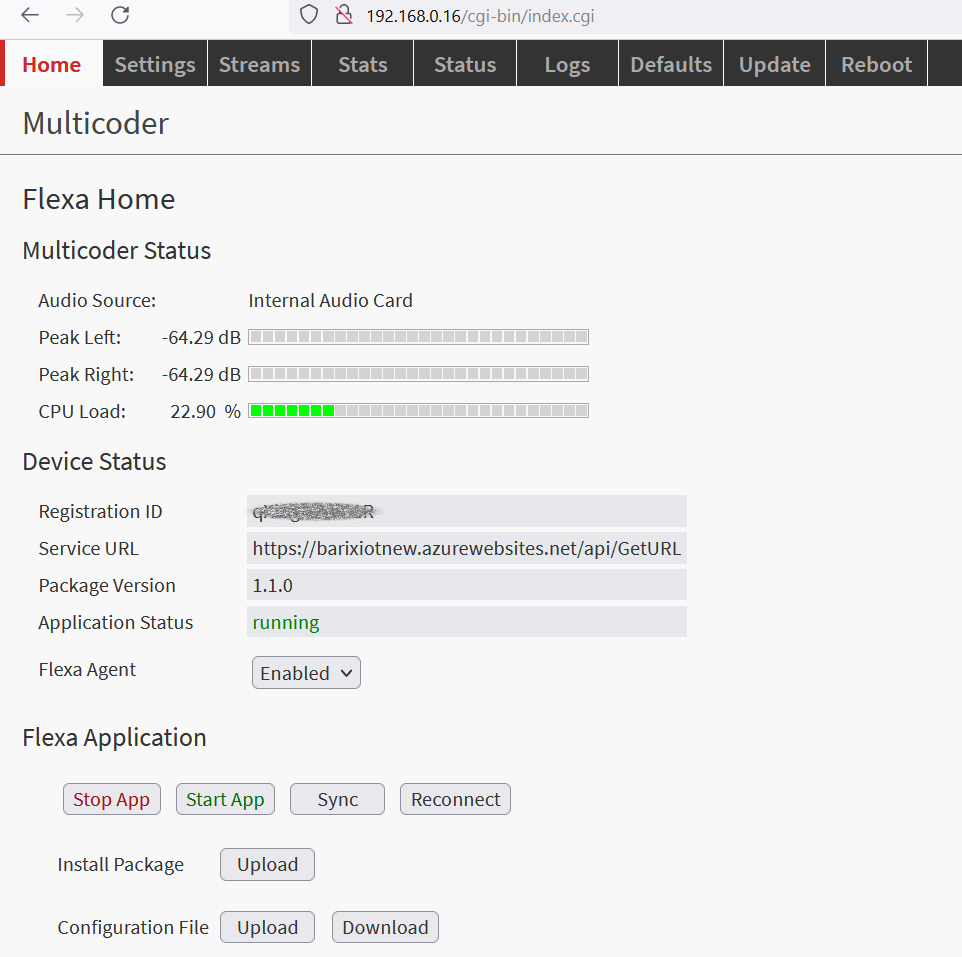
This page allows the stop and start of the Flexa application, but usually it should be not used. The ““Sync” button will connect to Barix Software could and check for available software/application on the service portal and update if necessary. As this application only runs on boot or periodically to contact remote Flexa services, it may be necessary to use this button to speed up the development when the application is served by service portal.
There are also 2 buttons:
Install Package: this function allows you to upload and install your application package from the web interface.
Load configuration file: this function allows you to upload a configuration file for your application to change parameters of the same.
The applications and configurations can be loaded manually, but that does not work with the Multicoder !
The Multicoder application should be started automatically after reboot.
If not, then you can start/stop the application over the “Start” and “Stop” button.
The Application Status must show “running”.
Now the device is ready to work and you can start to configure the device.
Streaming to Barix Exstreamers/decoders
The available streaming formats are even compatible with the supported streaming formats on the Barix Exstreamers.
For the Streaming Client firmware you can use all the audio formats except OPUS and AAC+ without SDP description. The streaming Client will auto-detect the streaming format from the sent RTP header. For MP3 streaming we recommend to use the CBR encoding.
When streaming to the Exstreamer M400, Exstreamer MPA400 or MPI400 then only the standardized formats can streamed without SDP description. For all other formats you have to import the SDP description in the source configuration of the decoder/receiver.
For that click on the “Show SDP” button on the Multicoder and copy the section for the according stream.
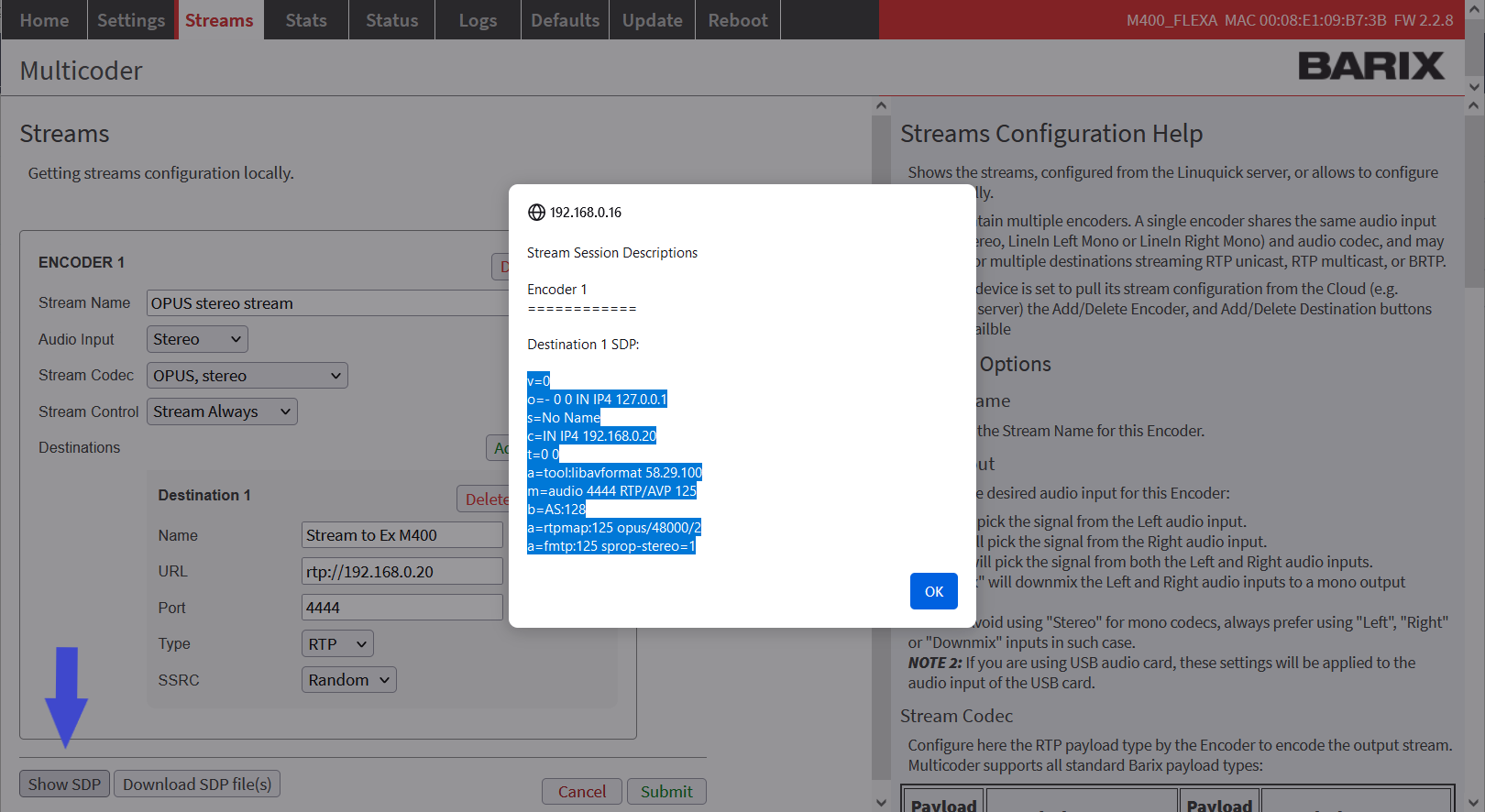
copy SDP parameters from Multicoder
Thereafter go to the IP Audio Client (IPAC) configuration on the Exstreamer M400/IPFormer/Annuncicom MPI400 and insert these lines directly in the RTP source.
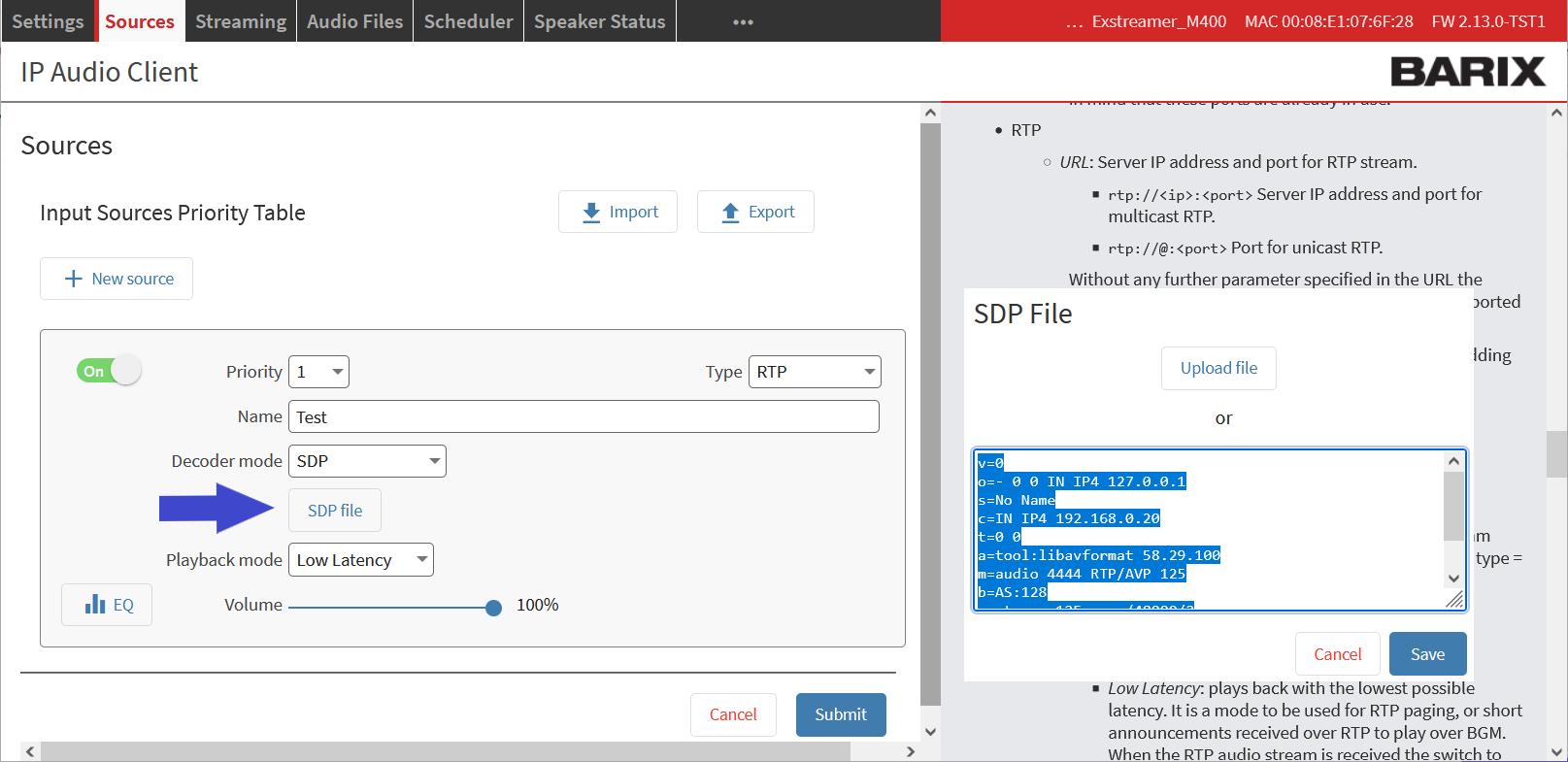
paste the SDP parameters in Exstreamer M400
Thereafter save the settings, ready.
Note, such SDP import function is only available on IPAC firmware v2.13 or newer.
Connecting USB Audio device
The Multicoder has Line-in interface connected to it internal audio card. Beside that it is possible to attach a USB audio to the “Ext” interface on the front side of the device. Only one USB Audio device will be accepted. For the USB support a generic USB driver is used which should cover a wide range of USB audio devices, e.g. USB microphone, USB audio cards, USB mixers and so on.
Unfortunately it can also happen that some less USB devices will be not supported.
We recommend to attach the USB device when the device is off.
When the USB device is properly inserted then you can power on the Multicoder.
In the Multicoder settings you should usually see now some specif parameters for the USB audio device.
These parameters can be different for each different USB device.
Following you see an example for such USB settings:
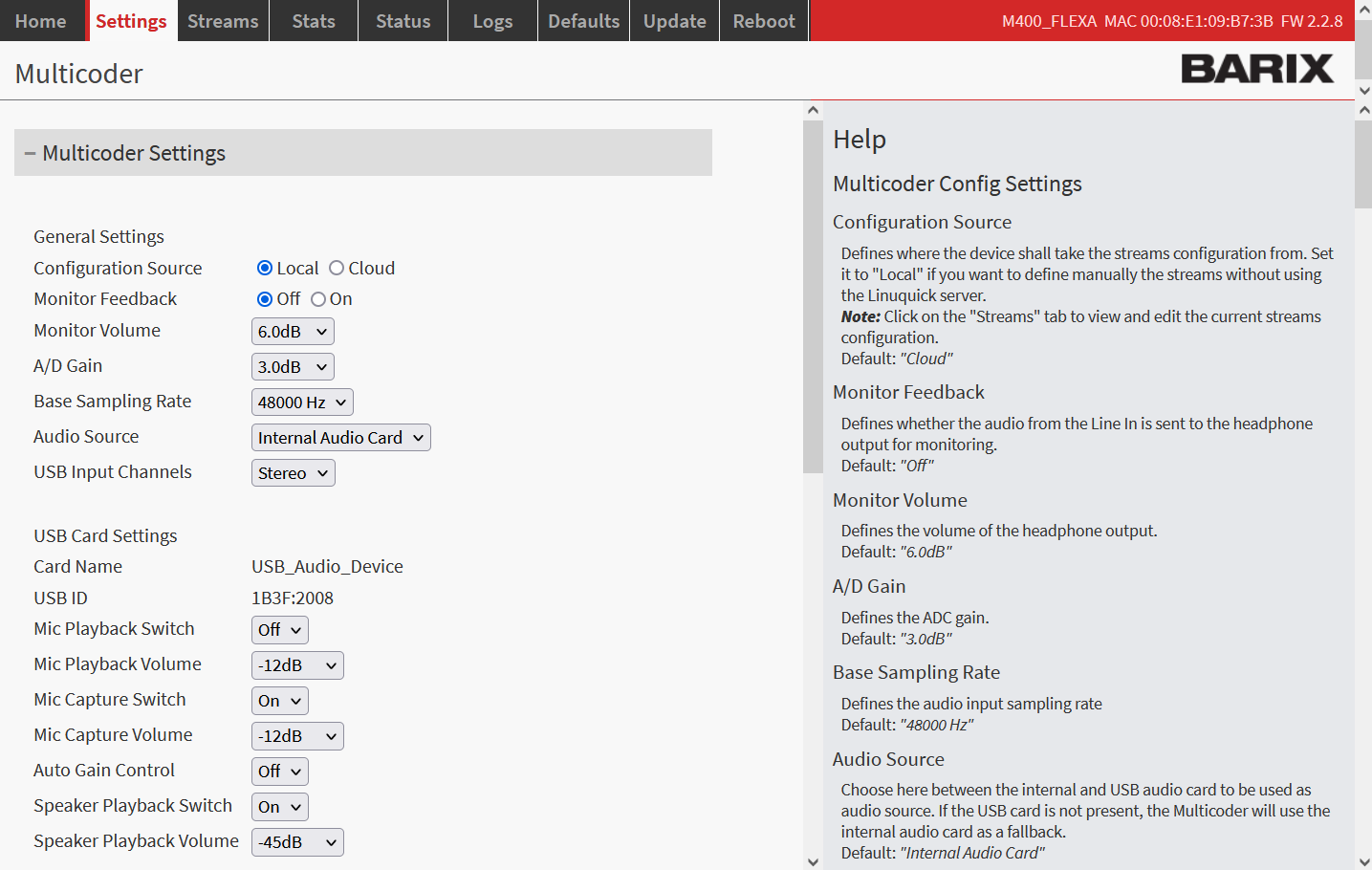
Example for USB specific settings
To activate the USB audio device you have to change the “Audio Source” setting to “USB Audio Card” and apply (click Submit) this setting.
For removing an USB audio devices we recommend to turn off the Multicoder first.
Stats Page
The Stats page gives a more details system overview.
The SDP parameters can be copied even from this page.
Reset to factory defaults – Hard reset
It is also possible to perform a hard reset. A hard reset will revert all settings to factory defaults including the network settings.
To perform a hard reset locate the reset button on the front panel of the Multicoder device and keep it pressed for approximately 11 seconds using a sharp-pointed tool while the device is running. The status led will blink green 3 times, informing that the reset operation is started. After a few seconds, the device will reboot with factory defaults. Reload the page after the operation is completed.
Attention, this procedure will reset all settings and delete the Multicoder application !
Thereafter it will reload the application from the Barix Cloud portal.
The device must have Internet access for that and must be registered on the Barix Cloud portal.
The procedure should be only used in emergency cases or on advice from the Barix Support.
If you have problems here, then please contact the Barix Support at support@barix.com.
Rescue Image Process
In some occasions it is possible that the application faces some issues that cannot be restored with a hard reset to default. In such cases the rescue image process is the last chance to recover the device.
Attention, this procedure will reset all settings and delete the Multicoder application !
Thereafter it will reload the application from the Barix Cloud portal.
The device must have Internet access for that and must be registered on the Barix Cloud portal.
The procedure should be only used in emergency cases or on advice from the Barix Support.
If you have problems here, then please contact the Barix Support at support@barix.com.
For the rescue image process execute following steps:
If your Multicoder device is powered, shut it off
Make sure the device is connected to internet. For this process to work the device will attempt a connection to Barix Download server via HTTP (port 80), if successful it will download the rescue image from this server. The Rescue process works only when there is a DHCP server in the local network.
While the device is off, press the reset button
Keep the button pressed while powering up the device
Keep the button pressed in for 34 seconds after the device is powered, then release
When the rescue process starts the led blinks orange
The device restarts and the LED will blink orange indicating a FW update/downgrade process is in progress
When the LED will turn green (blinking or steady), reboot the device
After this process the device will even download the Multicoder application from the Barix download server, which normally corresponds to the last one released.
Update
The Multicoder offers the possibility to update the firmware over the web interface.
Here only Flexa firmwares can be updated and will be accepted.
It is not possible to upload any other firmware type.
Run always the latest firmware available from Barix as it might include bug fixes, improvements or new useful features.
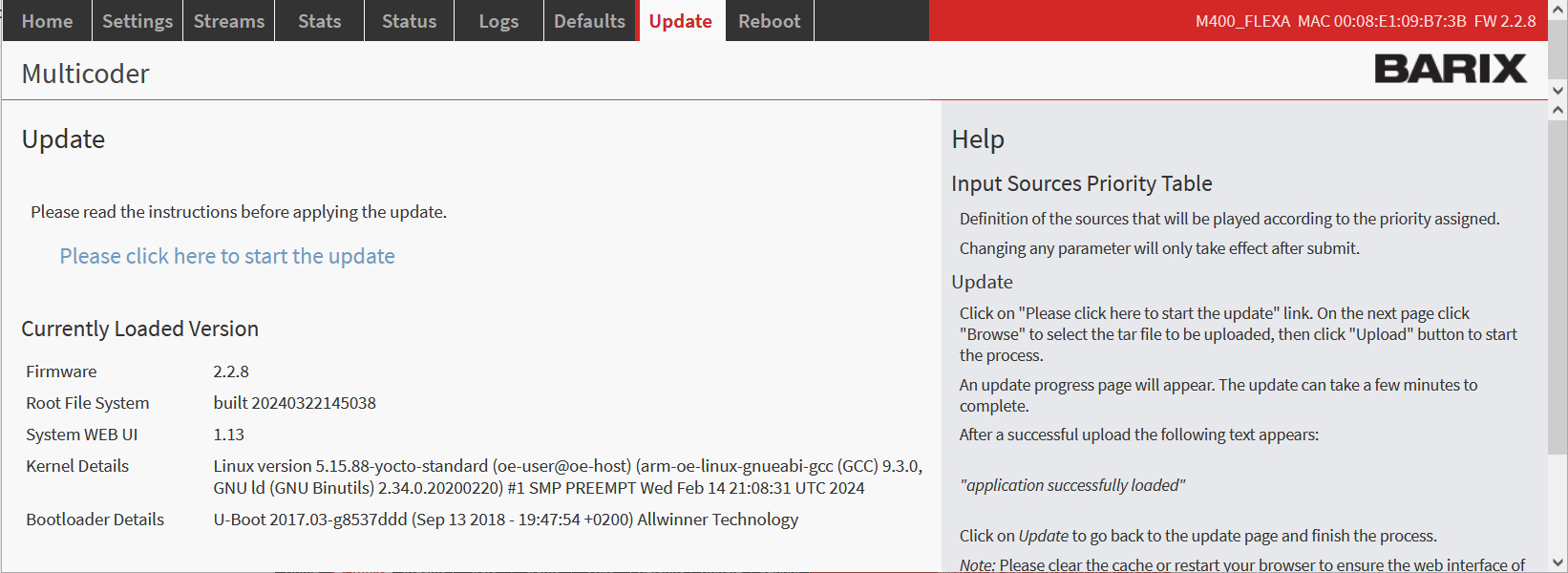
Update page
Reboot - web interface
Click "Reboot the device" to restart the device.
Thereafter the device will automatically start again.
The reboot is the process of power cycling the device (ON → OFF → ON). It’s a complete power cycle. The reboot can be performed from the web user interface or from the reset button located on the front panel of the device or by removing power for a few seconds.
Reboot - physical button
The reboot of the device from the button is performed by pressing the Reset button located on the front panel of the Multicoder device for ~3 seconds.
Compliance and further Information
This equipment has been tested and found to comply with the limits for a Class B digital device, pursuant to part 15 of the FCC Rules. These limits are designed to provide reasonable protection against harmful interference in a residential installation. This equipment generates, uses and can radiate radio frequency energy and, if not installed and used in accordance with the instructions, may cause harmful interference to radio communications. However, there is no guarantee that interference will not occur in a particular installation. If this equipment does cause harmful interference to radio or television reception, which can be determined by turning the equipment off and on, the user is encouraged to try to correct the interference by one or more of the following measures:
Reorient or relocate the receiving antenna.
Increase the separation between the equipment and receiver.
Connect the device into an outlet on a circuit different from that to which the receiver is connected.
Consult the dealer or an experienced radio/TV technician for help.
Safety and precaution recommendations apply. Find them in the download section at www.barix.com.

Find your distributor on this list for more hardware.
For questions that are extending the documentation, feel free to contact us on:
International: +41 434 33 22 22
USA: +1 866 815 0866
Email: support@barix.com
All information and the use of this product including all services are covered under the Barix Terms & Conditions and our Privacy Policy. Please follow the Safety and Precaution Recommendations. Barix is a ISO 9001:2015 certified company. All rights reserved. All information is subject to change without notice. All mentioned trademarks belong to their respective owners and are used for reference only.
